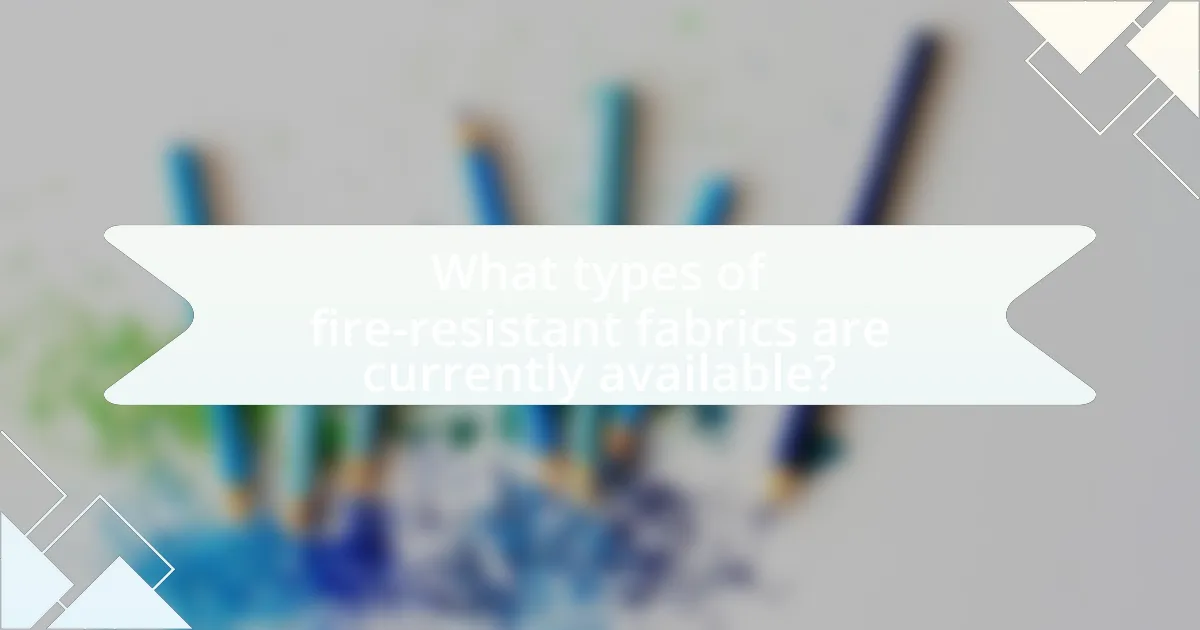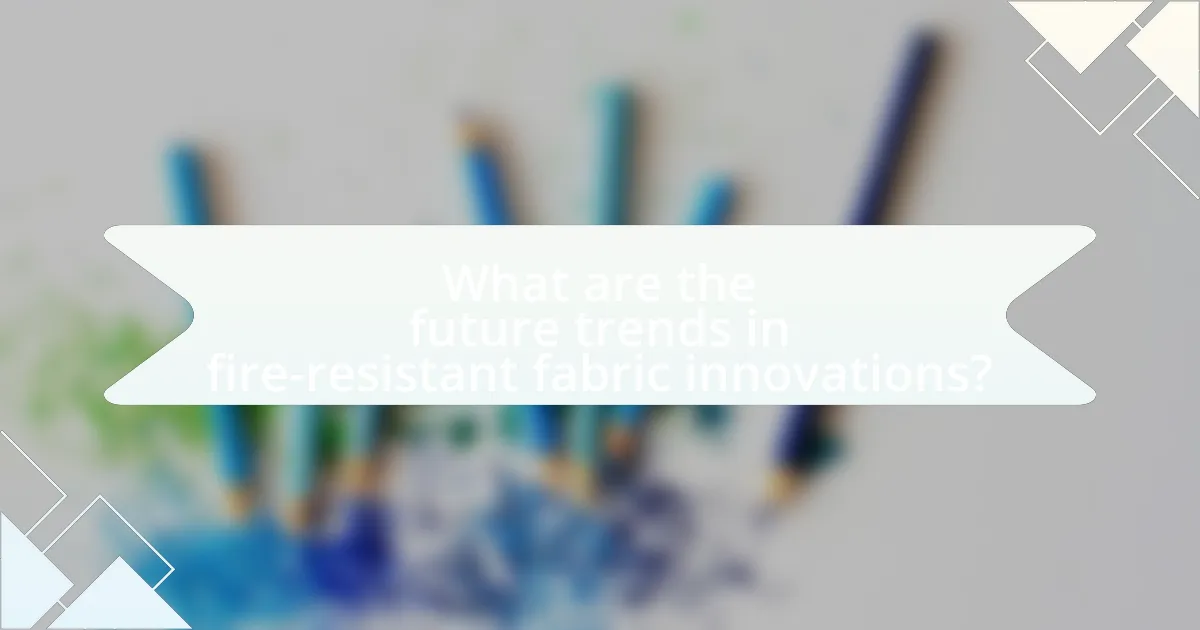Innovations in fire-resistant fabrics for safety applications focus on advanced materials such as aramid fibers, inherently flame-resistant textiles, and nanotechnology-enhanced coatings. These developments have evolved from traditional natural fibers to sophisticated synthetic options, significantly improving protection against heat and flames in industries like firefighting and manufacturing. Key advancements include the introduction of inherently flame-resistant materials that do not require chemical treatments, as well as the integration of smart technologies for real-time monitoring. The article also highlights the importance of compliance with safety standards and certifications, ensuring that these fabrics effectively reduce the risk of burns and injuries in hazardous environments.

What are Innovations in Fire-Resistant Fabrics for Safety Applications?
Innovations in fire-resistant fabrics for safety applications include the development of advanced materials such as aramid fibers, inherently flame-resistant textiles, and nanotechnology-enhanced coatings. Aramid fibers, like Kevlar and Nomex, provide high tensile strength and thermal stability, making them ideal for protective clothing used by firefighters and industrial workers. Inherently flame-resistant textiles, which do not require chemical treatments to achieve fire resistance, offer durability and comfort, exemplified by fabrics like Proban and Pyrovatex. Additionally, nanotechnology is being utilized to create coatings that enhance the fire resistance of conventional fabrics, improving their performance without compromising flexibility or breathability. These innovations are supported by research indicating that such materials can withstand higher temperatures and provide better protection against heat and flames, thereby enhancing safety in hazardous environments.
How have fire-resistant fabrics evolved over time?
Fire-resistant fabrics have evolved significantly from natural fibers to advanced synthetic materials. Initially, materials like wool and cotton were treated with chemical fire retardants to enhance their resistance to flames. Over time, the development of synthetic fibers, such as aramid (e.g., Kevlar and Nomex), revolutionized the industry by providing superior heat and flame resistance while maintaining lightweight and flexible properties.
In the late 20th century, advancements in nanotechnology and the incorporation of flame-retardant additives into polymers further improved the performance of these fabrics. For instance, the introduction of inherently flame-resistant fibers, which do not require chemical treatments, has led to increased durability and safety in various applications, including firefighting gear and industrial protective clothing.
The evolution of fire-resistant fabrics is evidenced by the growing standards and regulations, such as those set by the National Fire Protection Association (NFPA), which have driven innovation and adoption of these materials in safety applications.
What historical advancements have shaped fire-resistant fabric technology?
Historical advancements that have shaped fire-resistant fabric technology include the development of materials such as asbestos in the late 19th century, which provided significant heat resistance. The introduction of synthetic fibers like Nomex and Kevlar in the 1960s further revolutionized the field, offering enhanced durability and flame resistance. Additionally, the implementation of chemical treatments, such as flame retardants, in the 1970s improved the safety of various textiles. These advancements have been validated by their widespread use in protective clothing for firefighters and industrial workers, demonstrating their effectiveness in reducing burn injuries and fatalities.
What recent breakthroughs are influencing the current market?
Recent breakthroughs in fire-resistant fabrics, particularly the development of advanced polymer blends and nanotechnology, are significantly influencing the current market. These innovations enhance the thermal stability and durability of fabrics, making them more effective in safety applications such as protective clothing for firefighters and industrial workers. For instance, the introduction of aramid fibers combined with graphene has resulted in materials that not only resist high temperatures but also provide improved flexibility and comfort. Additionally, research published in the Journal of Fire Sciences highlights that these new materials can withstand extreme conditions while maintaining their structural integrity, thereby increasing their market demand in safety gear and protective equipment.
Why are fire-resistant fabrics important for safety applications?
Fire-resistant fabrics are crucial for safety applications because they provide essential protection against flames and heat, significantly reducing the risk of burns and injuries in hazardous environments. These materials are engineered to resist ignition and slow down the spread of fire, which is vital in industries such as firefighting, military, and manufacturing. For instance, the National Fire Protection Association (NFPA) emphasizes that using fire-resistant clothing can decrease burn injuries by up to 80% in certain scenarios. This effectiveness underscores the importance of incorporating fire-resistant fabrics into safety gear to enhance worker protection and compliance with safety regulations.
What role do these fabrics play in personal protective equipment?
Fire-resistant fabrics are essential components of personal protective equipment (PPE) as they provide critical protection against heat and flames. These fabrics are engineered to resist ignition and prevent the spread of fire, thereby safeguarding the wearer from severe burns and injuries in hazardous environments. For instance, materials such as Nomex and Kevlar are commonly used in firefighting gear and industrial workwear due to their high thermal stability and flame resistance. Studies have shown that PPE made from these advanced fabrics can significantly reduce the risk of thermal injuries, making them vital for professionals in firefighting, electrical work, and other high-risk occupations.
How do fire-resistant fabrics enhance safety in various industries?
Fire-resistant fabrics enhance safety in various industries by providing protection against flames and heat, thereby reducing the risk of burns and injuries. These materials are engineered to resist ignition and limit the spread of fire, which is critical in sectors such as firefighting, manufacturing, and oil and gas. For instance, the use of Nomex and Kevlar in protective clothing for firefighters has been shown to withstand high temperatures and provide thermal insulation, significantly lowering the likelihood of injury during fire-related incidents. Additionally, industries like aerospace and automotive utilize fire-resistant textiles to meet stringent safety regulations, ensuring that workers are safeguarded against potential fire hazards.

What types of fire-resistant fabrics are currently available?
Currently, there are several types of fire-resistant fabrics available, including aramid fibers, treated cotton, and inherently flame-resistant materials. Aramid fibers, such as Kevlar and Nomex, are widely used in protective clothing due to their high heat resistance and durability. Treated cotton fabrics are chemically treated to enhance their flame resistance, making them suitable for various applications, including workwear. Inherently flame-resistant materials, like modacrylic and certain blends, possess flame-resistant properties without the need for chemical treatments, ensuring long-lasting protection. These fabrics are essential in industries such as firefighting, military, and industrial safety, where protection against heat and flames is critical.
What materials are commonly used in fire-resistant fabrics?
Common materials used in fire-resistant fabrics include aramid fibers, such as Kevlar and Nomex, and treated cotton. Aramid fibers are known for their high strength and thermal stability, making them ideal for protective clothing in hazardous environments. Treated cotton, often combined with flame-retardant chemicals, provides comfort while enhancing fire resistance. These materials are widely utilized in industries such as firefighting, military, and industrial safety, demonstrating their effectiveness in protecting against heat and flames.
How do natural fibers compare to synthetic fibers in fire resistance?
Natural fibers generally have lower fire resistance compared to synthetic fibers. For instance, natural fibers like cotton and wool can ignite easily and burn quickly, while synthetic fibers such as aramid and polyester are engineered to resist flames and have higher ignition thresholds. Research indicates that aramid fibers, used in protective clothing, can withstand temperatures up to 370 degrees Celsius, whereas untreated cotton ignites at around 255 degrees Celsius. This significant difference in ignition temperatures highlights the superior fire resistance of synthetic fibers over natural fibers.
What are the advantages of using blended fabrics for fire resistance?
Blended fabrics offer enhanced fire resistance due to their combination of fibers, which can include both natural and synthetic materials. This combination allows for improved thermal stability and reduced flammability compared to single-fiber fabrics. For instance, blends of aramid fibers with cotton can provide better comfort and breathability while maintaining fire-resistant properties, making them suitable for protective clothing in hazardous environments. Additionally, blended fabrics can be engineered to meet specific safety standards, such as those set by the National Fire Protection Association (NFPA), ensuring that they provide adequate protection in various applications.
What are the key features of modern fire-resistant fabrics?
Modern fire-resistant fabrics are characterized by their ability to withstand high temperatures, resist ignition, and limit the spread of flames. These fabrics often incorporate advanced materials such as aramid fibers, which provide exceptional thermal stability and durability. Additionally, many modern fire-resistant fabrics are treated with chemical flame retardants that enhance their protective qualities without compromising flexibility or comfort. For instance, fabrics like Nomex and Kevlar are widely recognized for their effectiveness in personal protective equipment, demonstrating their capability to maintain structural integrity under extreme conditions.
How do moisture-wicking properties enhance comfort and safety?
Moisture-wicking properties enhance comfort and safety by effectively drawing sweat away from the skin, which helps maintain a stable body temperature and reduces the risk of overheating. When fabrics are designed with moisture-wicking technology, they facilitate quicker evaporation of perspiration, keeping the wearer dry and comfortable during physically demanding tasks. This is particularly crucial in safety applications, where overheating can lead to decreased performance and increased risk of accidents. Studies have shown that maintaining a lower skin temperature can improve focus and reaction times, thereby enhancing overall safety in hazardous environments.
What innovations improve the durability of fire-resistant fabrics?
Innovations that improve the durability of fire-resistant fabrics include the development of advanced fiber technologies, such as aramid and modacrylic fibers, which enhance thermal stability and resistance to wear. These fibers are engineered to withstand high temperatures and resist degradation over time, ensuring longevity in protective clothing. Additionally, the incorporation of durable water repellent (DWR) finishes and enhanced chemical treatments further increases the fabric’s resistance to environmental factors, thereby maintaining its fire-resistant properties under various conditions. Research has shown that fabrics treated with these innovations can significantly outperform traditional materials in terms of durability and safety, making them essential for applications in industries such as firefighting and industrial safety.

How are innovations in fire-resistant fabrics tested and certified?
Innovations in fire-resistant fabrics are tested and certified through standardized testing methods that evaluate their performance against fire hazards. These methods include the ASTM E84 test, which measures flame spread and smoke development, and the NFPA 701 test, which assesses the flammability of textiles. Certification is typically conducted by accredited laboratories that ensure compliance with industry standards, such as those set by the American National Standards Institute (ANSI) and the National Fire Protection Association (NFPA). These rigorous testing protocols provide evidence of a fabric’s ability to resist ignition and limit the spread of flames, ensuring safety in various applications.
What standards govern the testing of fire-resistant fabrics?
The standards that govern the testing of fire-resistant fabrics include ASTM E84, NFPA 701, and ISO 15025. ASTM E84, also known as the “Standard Test Method for Surface Burning Characteristics of Building Materials,” evaluates the flame spread and smoke development of materials. NFPA 701, the “Standard Methods of Fire Tests for Flame Propagation of Textiles and Films,” assesses the flammability of textiles used in interior applications. ISO 15025, titled “Textiles – Determination of the ignitability of flexible materials when exposed to a small flame,” measures the ignitability of fabrics. These standards ensure that fire-resistant fabrics meet safety and performance criteria essential for various applications.
How do testing methods vary across different applications?
Testing methods for fire-resistant fabrics vary significantly across applications due to differing performance requirements and regulatory standards. For instance, fabrics used in personal protective equipment (PPE) must undergo rigorous flame resistance tests, such as the ASTM D6413 standard, which measures vertical flame propagation, while materials intended for industrial applications may be evaluated using the NFPA 701 test for flammability. Additionally, fabrics designed for upholstery in public spaces often require compliance with specific fire safety codes, necessitating tests like the California Technical Bulletin 117. These variations ensure that each application meets the necessary safety standards and performance criteria, reflecting the unique risks associated with different environments.
What certifications should consumers look for in fire-resistant fabrics?
Consumers should look for certifications such as NFPA 701, ASTM E84, and ISO 15025 when selecting fire-resistant fabrics. NFPA 701 tests the flammability of textiles and ensures they meet safety standards for use in public spaces. ASTM E84 evaluates the surface burning characteristics of building materials, providing a measure of flame spread and smoke development. ISO 15025 assesses the protective clothing’s resistance to flame exposure, ensuring that the fabric can withstand high temperatures without igniting. These certifications provide assurance that the fabrics have been rigorously tested for fire resistance and meet industry safety standards.
How do manufacturers ensure the quality of fire-resistant fabrics?
Manufacturers ensure the quality of fire-resistant fabrics through rigorous testing and adherence to industry standards. They conduct flame resistance tests, such as the ASTM D6413 standard, which measures the fabric’s ability to resist ignition and limit flame spread. Additionally, manufacturers often utilize advanced materials like aramid fibers and treated cotton, which have proven fire-resistant properties. Quality assurance processes, including inspections and certifications from recognized organizations like Underwriters Laboratories (UL), further validate the performance of these fabrics in real-world applications.
What role does quality control play in fabric production?
Quality control is essential in fabric production as it ensures that the materials meet specific standards for safety, durability, and performance. In the context of fire-resistant fabrics, quality control processes involve rigorous testing for flame resistance, thermal stability, and overall fabric integrity. For instance, the National Fire Protection Association (NFPA) sets standards that fabrics must meet to be classified as fire-resistant, which includes tests for ignition resistance and heat transfer. By adhering to these standards, manufacturers can guarantee that their products provide the necessary protection in safety applications, thereby reducing the risk of failure in critical situations.
How can consumers assess the reliability of fire-resistant fabric products?
Consumers can assess the reliability of fire-resistant fabric products by examining certifications, testing standards, and manufacturer reputation. Certifications such as NFPA 701 or ASTM E84 indicate that the fabric has undergone rigorous testing for flame resistance. Additionally, consumers should look for compliance with industry standards, which provide assurance of the product’s performance in fire situations. Research from the National Fire Protection Association highlights that fabrics meeting these standards significantly reduce the risk of ignition and flame spread. Furthermore, reviewing customer feedback and manufacturer history can provide insights into the durability and effectiveness of the fabric in real-world applications.

What are the future trends in fire-resistant fabric innovations?
Future trends in fire-resistant fabric innovations include the development of advanced materials that enhance thermal protection, such as nanofibers and bio-based fibers. These materials are being engineered to improve comfort and breathability while maintaining high levels of flame resistance. For instance, research indicates that incorporating graphene into fabrics can significantly increase their thermal stability and reduce weight, making them more suitable for various applications, including personal protective equipment and industrial use. Additionally, the integration of smart technologies, such as temperature sensors within fabrics, is emerging, allowing for real-time monitoring of heat exposure. This trend is supported by ongoing advancements in textile engineering and materials science, which aim to meet the increasing safety standards in industries like firefighting and aerospace.
How is technology shaping the future of fire-resistant fabrics?
Technology is shaping the future of fire-resistant fabrics through advancements in material science, specifically the development of new synthetic fibers and coatings that enhance flame resistance. Innovations such as the incorporation of nanotechnology and the use of inherently flame-retardant materials, like aramid fibers and modified polyester, significantly improve the thermal stability and durability of these fabrics. For instance, research published in the Journal of Fire Sciences demonstrates that fabrics treated with nanomaterials exhibit superior fire resistance compared to traditional treatments, providing longer-lasting protection. Additionally, smart textiles that integrate sensors for real-time monitoring of temperature and exposure to flames are emerging, further enhancing safety in hazardous environments.
What role do nanotechnology and smart textiles play in advancements?
Nanotechnology and smart textiles significantly enhance advancements in fire-resistant fabrics by improving their protective properties and functionality. Nanotechnology enables the incorporation of nanoparticles into textiles, which can enhance flame resistance, reduce heat transfer, and provide self-extinguishing capabilities. For instance, research has shown that fabrics treated with nanomaterials can achieve higher thermal stability and lower flammability ratings compared to conventional materials. Smart textiles, equipped with sensors and responsive materials, can monitor environmental conditions and provide real-time feedback, enhancing safety in hazardous situations. This integration of technology not only improves the performance of fire-resistant fabrics but also contributes to the development of innovative safety applications in various industries, including firefighting and industrial safety.
How might sustainability influence future fabric innovations?
Sustainability will significantly influence future fabric innovations by driving the development of eco-friendly materials and production processes. As consumer demand for sustainable products increases, manufacturers are likely to invest in biodegradable fibers, recycled materials, and low-impact dyeing techniques. For instance, the global market for sustainable textiles is projected to reach $8.25 billion by 2027, indicating a strong trend towards environmentally responsible fabric solutions. This shift not only addresses environmental concerns but also aligns with regulatory pressures and corporate social responsibility initiatives, further reinforcing the need for innovation in sustainable fabric technologies.
What practical tips should consumers consider when choosing fire-resistant fabrics?
When choosing fire-resistant fabrics, consumers should prioritize materials that meet established safety standards, such as those set by the National Fire Protection Association (NFPA) or Underwriters Laboratories (UL). These standards ensure that the fabrics have been rigorously tested for flame resistance and durability. Additionally, consumers should consider the specific application of the fabric, as different environments may require varying levels of fire resistance. For instance, fabrics used in industrial settings may need to withstand higher temperatures compared to those used in home furnishings. Furthermore, checking for certifications and labels that indicate compliance with fire safety regulations can provide assurance of the fabric’s effectiveness.
How can users determine the best fabric for their specific needs?
Users can determine the best fabric for their specific needs by assessing the fabric’s fire-resistance rating, durability, and comfort level. Fire-resistance ratings, such as those defined by ASTM standards, indicate how well a fabric can withstand flames and heat, which is crucial for safety applications. Additionally, evaluating the fabric’s durability ensures it can withstand wear and tear in demanding environments, while comfort level affects usability for the wearer. For instance, fabrics like Nomex and Kevlar are widely recognized for their superior fire resistance and durability, making them suitable for protective clothing in hazardous occupations.
What maintenance practices extend the life of fire-resistant fabrics?
Regular cleaning and proper storage are essential maintenance practices that extend the life of fire-resistant fabrics. Cleaning should be done according to the manufacturer’s guidelines, typically involving gentle washing with mild detergents to remove contaminants without damaging the fabric’s protective properties. Additionally, storing fire-resistant fabrics in a cool, dry place away from direct sunlight and moisture helps prevent degradation. Research indicates that following these practices can significantly enhance the durability and effectiveness of fire-resistant materials, ensuring they maintain their protective qualities over time.

Leave a Reply